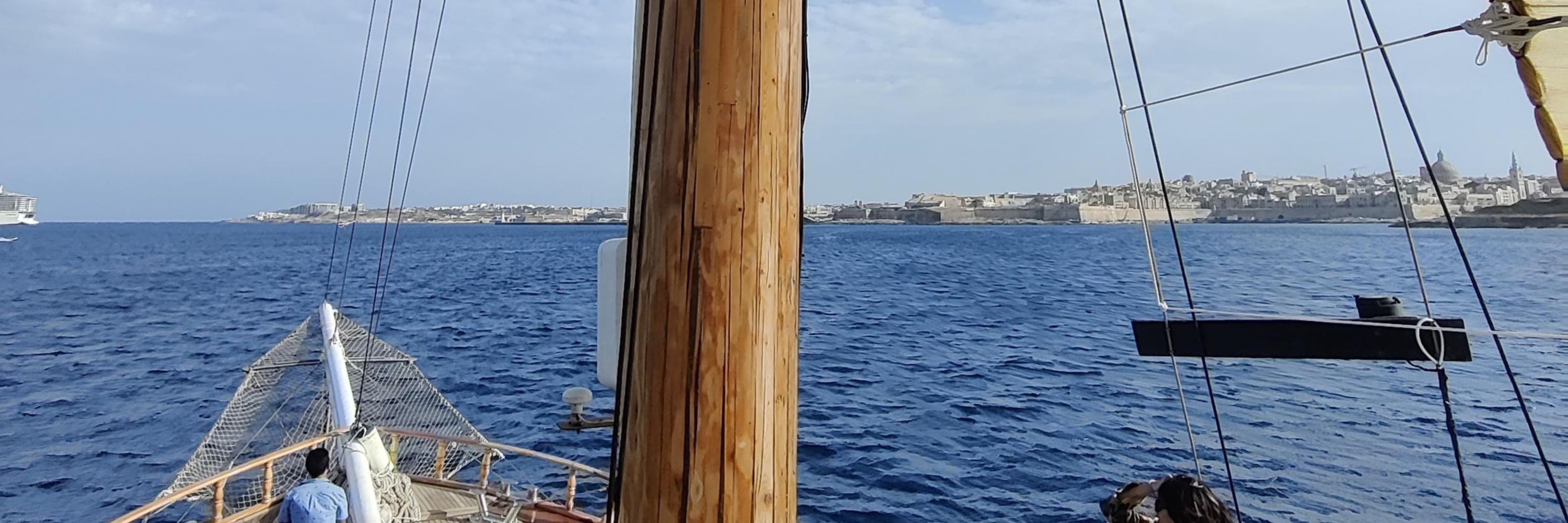
Jake Xuereb
@curlyqubit.bsky.social
🇲🇹 📍🇦🇹 // Quantum Physics PhD student
thinking thermodynamically @quitphysics.info
// Founder @qalypsoschool
// Startups, music and running elsewhere in spacetime.
thinking thermodynamically @quitphysics.info
// Founder @qalypsoschool
// Startups, music and running elsewhere in spacetime.
arxiv.org/abs/2511.02683
Gravity mediated entanglement arXiv posting of the day.
This time from across the road, IQOQI Vienna's Andrea di Biagio reminds us about important assumptions different models make and why it's hard to make a model independent no-go theorem.
Gravity mediated entanglement arXiv posting of the day.
This time from across the road, IQOQI Vienna's Andrea di Biagio reminds us about important assumptions different models make and why it's hard to make a model independent no-go theorem.

November 5, 2025 at 8:29 AM
arxiv.org/abs/2511.02683
Gravity mediated entanglement arXiv posting of the day.
This time from across the road, IQOQI Vienna's Andrea di Biagio reminds us about important assumptions different models make and why it's hard to make a model independent no-go theorem.
Gravity mediated entanglement arXiv posting of the day.
This time from across the road, IQOQI Vienna's Andrea di Biagio reminds us about important assumptions different models make and why it's hard to make a model independent no-go theorem.
"no amount of QFT machinery will ever change that fact"
Who needs reality TV when you've got quant-ph arguments about the quantum nature of gravity
I'm biased towards the guys with the peer reviewed careful math, not the overnight 2 eq arxiv posting tbh
arxiv.org/abs/2510.19969
Who needs reality TV when you've got quant-ph arguments about the quantum nature of gravity
I'm biased towards the guys with the peer reviewed careful math, not the overnight 2 eq arxiv posting tbh
arxiv.org/abs/2510.19969

October 24, 2025 at 5:36 AM
"no amount of QFT machinery will ever change that fact"
Who needs reality TV when you've got quant-ph arguments about the quantum nature of gravity
I'm biased towards the guys with the peer reviewed careful math, not the overnight 2 eq arxiv posting tbh
arxiv.org/abs/2510.19969
Who needs reality TV when you've got quant-ph arguments about the quantum nature of gravity
I'm biased towards the guys with the peer reviewed careful math, not the overnight 2 eq arxiv posting tbh
arxiv.org/abs/2510.19969
V3 of this manuscript is on the arXiv today : arxiv.org/abs/2505.15887
You'll find :
-a friendlier presentation for people from outside the quantum thermosphere
-a probabilistic bipartite heat exchange that approaches the capabilities of the n-partite interaction of V1
-cleaner inequalities!
You'll find :
-a friendlier presentation for people from outside the quantum thermosphere
-a probabilistic bipartite heat exchange that approaches the capabilities of the n-partite interaction of V1
-cleaner inequalities!

October 17, 2025 at 7:26 AM
V3 of this manuscript is on the arXiv today : arxiv.org/abs/2505.15887
You'll find :
-a friendlier presentation for people from outside the quantum thermosphere
-a probabilistic bipartite heat exchange that approaches the capabilities of the n-partite interaction of V1
-cleaner inequalities!
You'll find :
-a friendlier presentation for people from outside the quantum thermosphere
-a probabilistic bipartite heat exchange that approaches the capabilities of the n-partite interaction of V1
-cleaner inequalities!
I am learning so much about learning

October 9, 2025 at 12:43 PM
I am learning so much about learning
Good morning from TQC 2025 in Bengalore IISC 🇮🇳
I'm here spreading some Quantum Thermo propaganda to the Algo, Crypto people - pass by poster 72 if interested in (arxiv.org/abs/2505.15887)
Bengalore has been overwhelming, awesome, beautiful and tasty so far
I'm here spreading some Quantum Thermo propaganda to the Algo, Crypto people - pass by poster 72 if interested in (arxiv.org/abs/2505.15887)
Bengalore has been overwhelming, awesome, beautiful and tasty so far




September 15, 2025 at 5:35 AM
Good morning from TQC 2025 in Bengalore IISC 🇮🇳
I'm here spreading some Quantum Thermo propaganda to the Algo, Crypto people - pass by poster 72 if interested in (arxiv.org/abs/2505.15887)
Bengalore has been overwhelming, awesome, beautiful and tasty so far
I'm here spreading some Quantum Thermo propaganda to the Algo, Crypto people - pass by poster 72 if interested in (arxiv.org/abs/2505.15887)
Bengalore has been overwhelming, awesome, beautiful and tasty so far
(7/n) Now, 3 weeks ago Konstantin Beyer, Kim who's still around from the first paper and Pikowski have shown how to verify quantumness of an inaccessible object using only a single quantum probe.
To do this, they must act sequentially and with access to a memory system.
arxiv.org/abs/2507.15588
To do this, they must act sequentially and with access to a memory system.
arxiv.org/abs/2507.15588

August 13, 2025 at 8:59 AM
(7/n) Now, 3 weeks ago Konstantin Beyer, Kim who's still around from the first paper and Pikowski have shown how to verify quantumness of an inaccessible object using only a single quantum probe.
To do this, they must act sequentially and with access to a memory system.
arxiv.org/abs/2507.15588
To do this, they must act sequentially and with access to a memory system.
arxiv.org/abs/2507.15588
(6/n) The idea here is two drop two object simultaneously through two stern gerlach type interferometers then allowing them to interact via gravity during a brief free fall.
If gravity mediates entanglement between the two masses, it acts like the inaccessible mirror in the cavity, and is quantum!
If gravity mediates entanglement between the two masses, it acts like the inaccessible mirror in the cavity, and is quantum!

August 13, 2025 at 8:59 AM
(6/n) The idea here is two drop two object simultaneously through two stern gerlach type interferometers then allowing them to interact via gravity during a brief free fall.
If gravity mediates entanglement between the two masses, it acts like the inaccessible mirror in the cavity, and is quantum!
If gravity mediates entanglement between the two masses, it acts like the inaccessible mirror in the cavity, and is quantum!
(5/n) This reinvigorates the experimental tests of the quantumness of gravity discussions leading to the spin entanglement witness experimental proposal of Bose et al (ft. Paternostro and Kim that have been with us since paper 1)
arxiv.org/abs/1707.06050
arxiv.org/abs/1707.06050

August 13, 2025 at 8:59 AM
(5/n) This reinvigorates the experimental tests of the quantumness of gravity discussions leading to the spin entanglement witness experimental proposal of Bose et al (ft. Paternostro and Kim that have been with us since paper 1)
arxiv.org/abs/1707.06050
arxiv.org/abs/1707.06050
(4/n) 10 yrs later Krisnanda, Zuppardo, Paternostro & Paterek generalize the idea: if two probes, which don’t talk directly, gain entanglement via a mediator, the mediator must be quantum.
They suggest this set up could be used as a way to test the quantumness of gravity.
arxiv.org/abs/1607.01140
They suggest this set up could be used as a way to test the quantumness of gravity.
arxiv.org/abs/1607.01140

August 13, 2025 at 8:59 AM
(4/n) 10 yrs later Krisnanda, Zuppardo, Paternostro & Paterek generalize the idea: if two probes, which don’t talk directly, gain entanglement via a mediator, the mediator must be quantum.
They suggest this set up could be used as a way to test the quantumness of gravity.
arxiv.org/abs/1607.01140
They suggest this set up could be used as a way to test the quantumness of gravity.
arxiv.org/abs/1607.01140
(3/n) The correlations between the two light modes which one can measure, can be used to infer correlations that build up between the inaccessible mirror and either of the cavity modes.
The idea is based on the monogamy of entanglement. You can't have AC entanglement without some AB at some point.
The idea is based on the monogamy of entanglement. You can't have AC entanglement without some AB at some point.

August 13, 2025 at 8:59 AM
(3/n) The correlations between the two light modes which one can measure, can be used to infer correlations that build up between the inaccessible mirror and either of the cavity modes.
The idea is based on the monogamy of entanglement. You can't have AC entanglement without some AB at some point.
The idea is based on the monogamy of entanglement. You can't have AC entanglement without some AB at some point.
(2/n) In 2007 Paternostro and an author list rivaling the avengers wanted to see if they could probe entanglement building up between light and an inaccessible mirror.
The trick : put the mirror in the middle of a cavity and shoot light at it from either side.
arxiv.org/abs/quant-ph...
The trick : put the mirror in the middle of a cavity and shoot light at it from either side.
arxiv.org/abs/quant-ph...

August 13, 2025 at 8:59 AM
(2/n) In 2007 Paternostro and an author list rivaling the avengers wanted to see if they could probe entanglement building up between light and an inaccessible mirror.
The trick : put the mirror in the middle of a cavity and shoot light at it from either side.
arxiv.org/abs/quant-ph...
The trick : put the mirror in the middle of a cavity and shoot light at it from either side.
arxiv.org/abs/quant-ph...
(1/n) I’ve been binging some golden oldies from the optomech boom of the late 2000s and was surprised to find that the currently popular gravitationally mediated entanglement "is gravity quantum" experimental proposals -- find their origin there. Here’s a little thread on that lineage.
🧵
🧵

August 13, 2025 at 8:59 AM
(1/n) I’ve been binging some golden oldies from the optomech boom of the late 2000s and was surprised to find that the currently popular gravitationally mediated entanglement "is gravity quantum" experimental proposals -- find their origin there. Here’s a little thread on that lineage.
🧵
🧵
I've gotten into dumpster diving through Scirate for old discussions. A journal club with a time machine.
Here's one on how you could build a Qcomputer out of 1 photon but "a photon as wide as the universe would be like ∼100 qubits" from @mankei-tsang.bsky.social
scirate.com/arxiv/1909.0...
Here's one on how you could build a Qcomputer out of 1 photon but "a photon as wide as the universe would be like ∼100 qubits" from @mankei-tsang.bsky.social
scirate.com/arxiv/1909.0...

August 12, 2025 at 11:07 AM
I've gotten into dumpster diving through Scirate for old discussions. A journal club with a time machine.
Here's one on how you could build a Qcomputer out of 1 photon but "a photon as wide as the universe would be like ∼100 qubits" from @mankei-tsang.bsky.social
scirate.com/arxiv/1909.0...
Here's one on how you could build a Qcomputer out of 1 photon but "a photon as wide as the universe would be like ∼100 qubits" from @mankei-tsang.bsky.social
scirate.com/arxiv/1909.0...
(2/3) Interestingly, it seems one can only beat the classical probabilistic sample complexity if the the two scenarios lead to probe ground state populations that are different enough. We call this "t" the distinguishability parameter in the manuscript.

July 29, 2025 at 6:37 AM
(2/3) Interestingly, it seems one can only beat the classical probabilistic sample complexity if the the two scenarios lead to probe ground state populations that are different enough. We call this "t" the distinguishability parameter in the manuscript.
View of the Maltese Archipelago from Gozo this morning 🇲🇹

July 12, 2025 at 7:07 AM
View of the Maltese Archipelago from Gozo this morning 🇲🇹
(7/n) This was only possible and fun thanks to a great group of people.
Thanks to Jinming, an undergrad intern who kind of inspired the project. My close collaborator Ben Stratton for the weekly Zooms. Alberto for making our math solid. And Pharnam and Marcus for the guidance.
Thanks to Jinming, an undergrad intern who kind of inspired the project. My close collaborator Ben Stratton for the weekly Zooms. Alberto for making our math solid. And Pharnam and Marcus for the guidance.
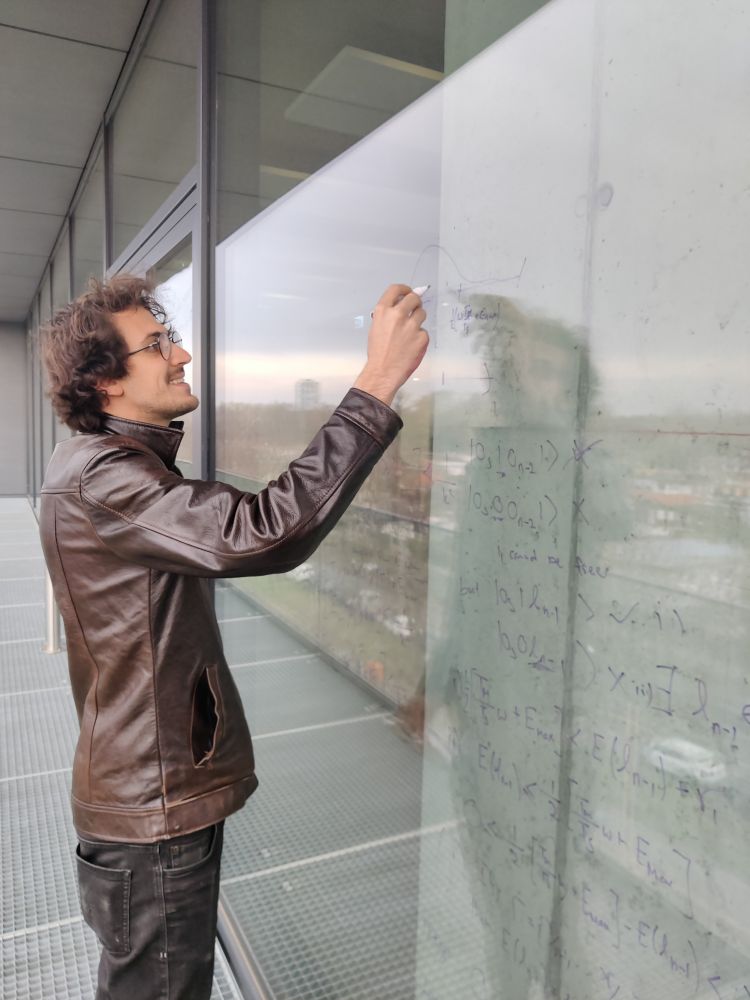
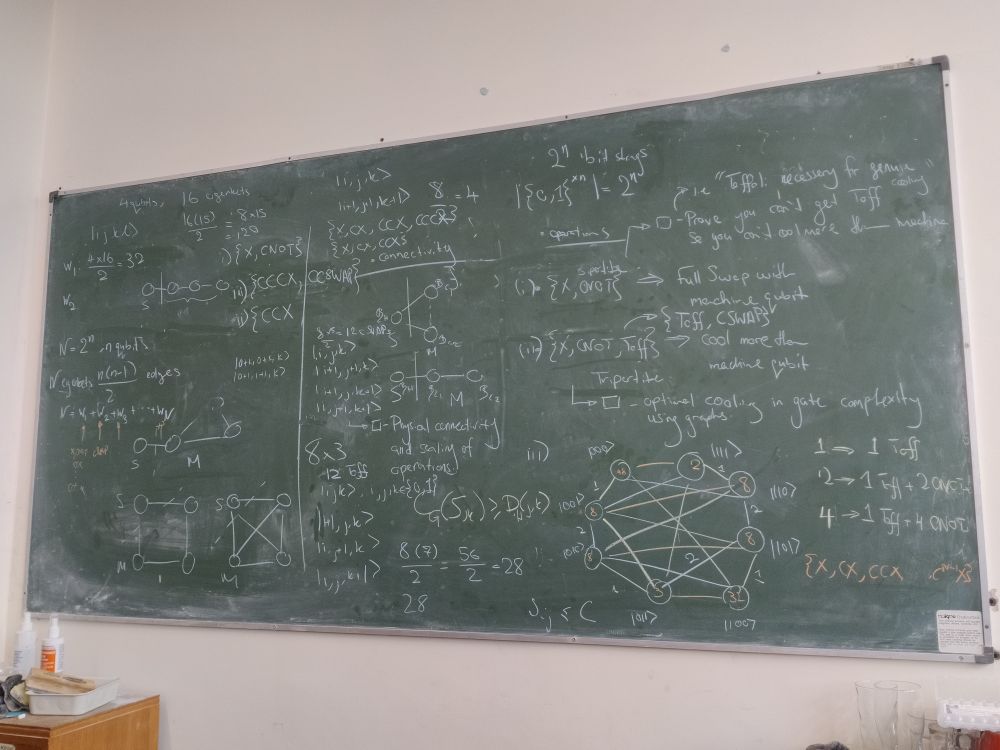

June 13, 2025 at 6:27 AM
(7/n) This was only possible and fun thanks to a great group of people.
Thanks to Jinming, an undergrad intern who kind of inspired the project. My close collaborator Ben Stratton for the weekly Zooms. Alberto for making our math solid. And Pharnam and Marcus for the guidance.
Thanks to Jinming, an undergrad intern who kind of inspired the project. My close collaborator Ben Stratton for the weekly Zooms. Alberto for making our math solid. And Pharnam and Marcus for the guidance.
(6/n) We continue to do a whole host of things, like prove a Carnot like limit on how much you can cool per step of a protocol
But our last contribution is a method to optimise cooling unitaries by showing they can be reduced to perfect matchings on bipartite graphs.
But our last contribution is a method to optimise cooling unitaries by showing they can be reduced to perfect matchings on bipartite graphs.

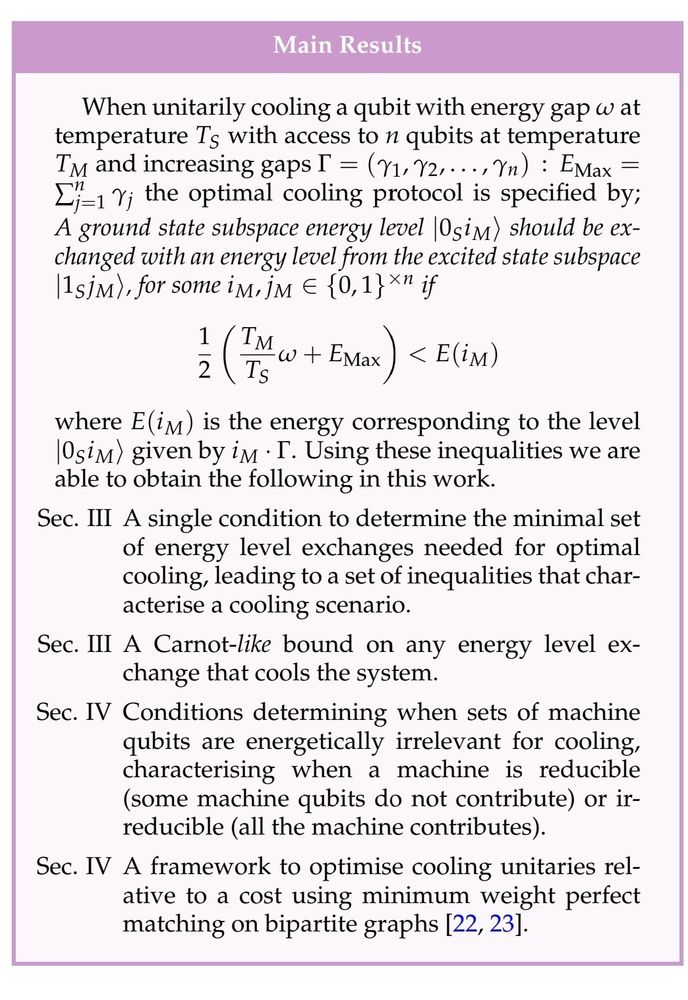
June 13, 2025 at 6:27 AM
(6/n) We continue to do a whole host of things, like prove a Carnot like limit on how much you can cool per step of a protocol
But our last contribution is a method to optimise cooling unitaries by showing they can be reduced to perfect matchings on bipartite graphs.
But our last contribution is a method to optimise cooling unitaries by showing they can be reduced to perfect matchings on bipartite graphs.
(3/n) We term this, k-reducibility, when a cooling scenario involving an n qubit machine can be reducd to one on n-k qubits -- meaning k of your qubits were useless!
This is fully characterised by our inequalities which show that it's the energetic structure of machines which underpins reducibility
This is fully characterised by our inequalities which show that it's the energetic structure of machines which underpins reducibility
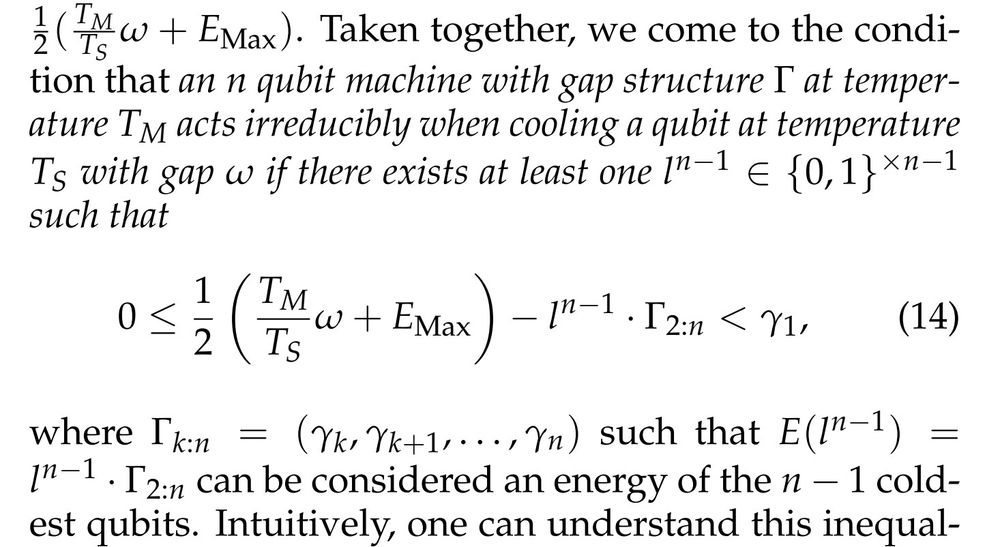
June 13, 2025 at 6:27 AM
(3/n) We term this, k-reducibility, when a cooling scenario involving an n qubit machine can be reducd to one on n-k qubits -- meaning k of your qubits were useless!
This is fully characterised by our inequalities which show that it's the energetic structure of machines which underpins reducibility
This is fully characterised by our inequalities which show that it's the energetic structure of machines which underpins reducibility
(2/n) When starting to looking into this problem we were interested in understanding "when is cooling hard?" i.e. when is the unitary required to cool something complex.
E.g. in cooling a qubit with two others, when does cooling require a bipartite or tripartite interaction?
E.g. in cooling a qubit with two others, when does cooling require a bipartite or tripartite interaction?
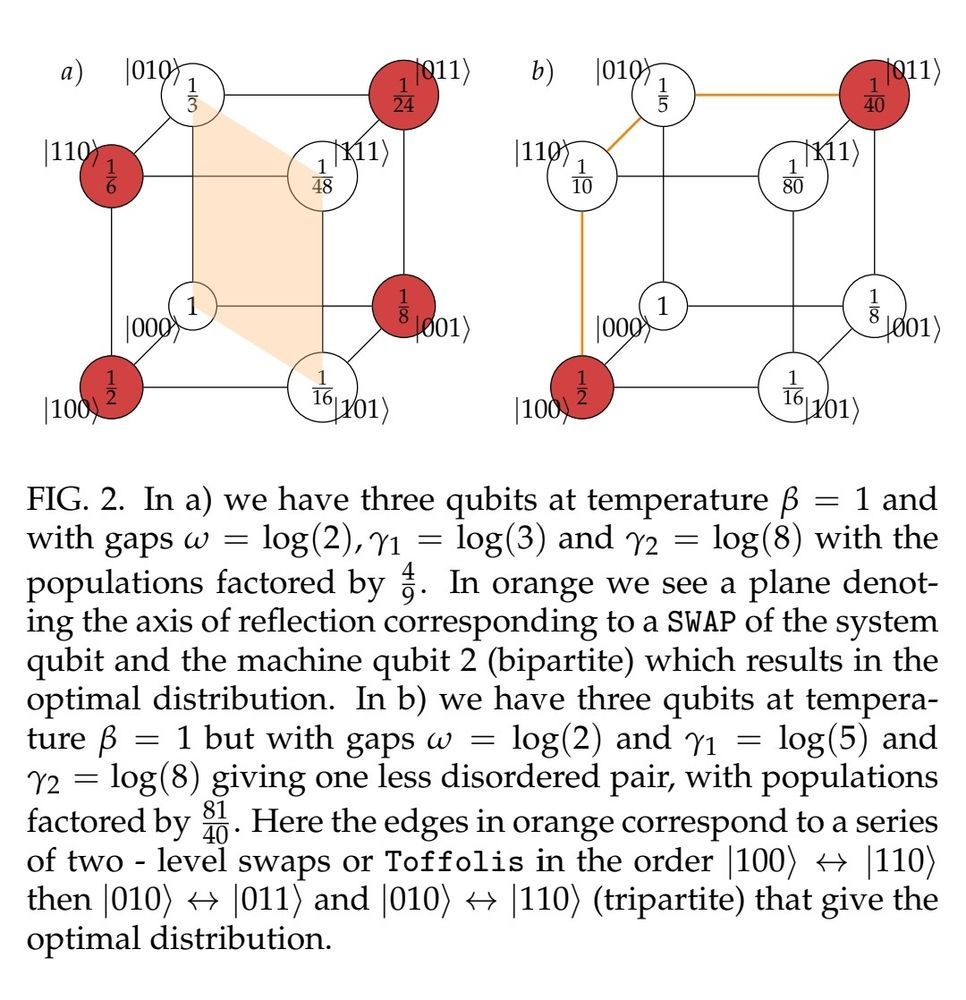
June 13, 2025 at 6:27 AM
(2/n) When starting to looking into this problem we were interested in understanding "when is cooling hard?" i.e. when is the unitary required to cool something complex.
E.g. in cooling a qubit with two others, when does cooling require a bipartite or tripartite interaction?
E.g. in cooling a qubit with two others, when does cooling require a bipartite or tripartite interaction?
(1/n) Today on the arXiv, we examine the folklore that cooling a quantum system with access to another requires one to order their joint state eigenvalues in decreasing order and find that this sorting is actually dictated by a simple set of inequalities.
scirate.com/arxiv/2506.1...
scirate.com/arxiv/2506.1...
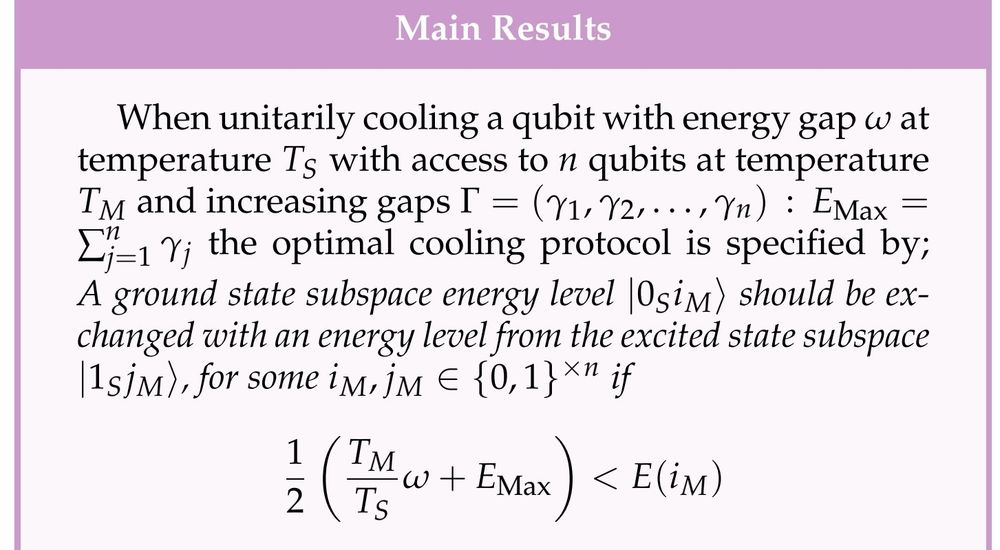
June 13, 2025 at 6:27 AM
(1/n) Today on the arXiv, we examine the folklore that cooling a quantum system with access to another requires one to order their joint state eigenvalues in decreasing order and find that this sorting is actually dictated by a simple set of inequalities.
scirate.com/arxiv/2506.1...
scirate.com/arxiv/2506.1...
Totally like not tweeting about this for any specific reasons but the surname Jozsa as in Deutsch-Jozsa is spelled "zs" not "sz" in case like I dunno you like umm put an arxiv posting with this name in the title...

June 6, 2025 at 12:32 PM
Totally like not tweeting about this for any specific reasons but the surname Jozsa as in Deutsch-Jozsa is spelled "zs" not "sz" in case like I dunno you like umm put an arxiv posting with this name in the title...
(6/7) Most importantly, since we've encoded our solution into a property of a mixed state - we need samples! Thankfully and surprisingly, if an energetic condition is satisfied, the no. of samples required to solve Deutsch-Josza is independent of the problem size!
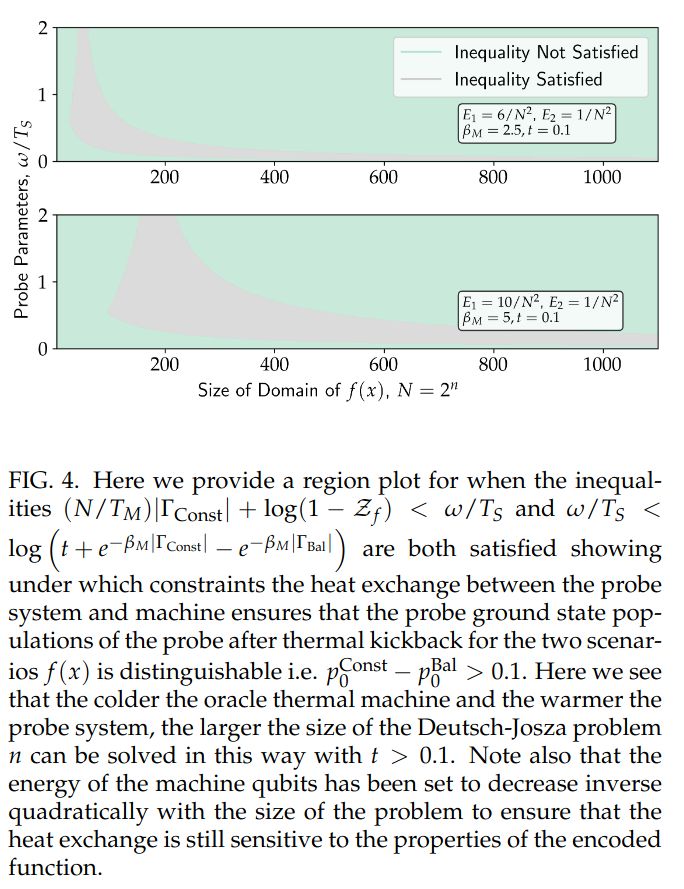
May 23, 2025 at 6:29 AM
(6/7) Most importantly, since we've encoded our solution into a property of a mixed state - we need samples! Thankfully and surprisingly, if an energetic condition is satisfied, the no. of samples required to solve Deutsch-Josza is independent of the problem size!
(5/7) Fascinatingly, the probe temperature and energy must scale with the size of the problem to be sensitive to it - but not too much! Or it'll become insensitive to the difference between the different scenarios.
This is my favorite insight, giving a notion of thermo cost for a query.
This is my favorite insight, giving a notion of thermo cost for a query.
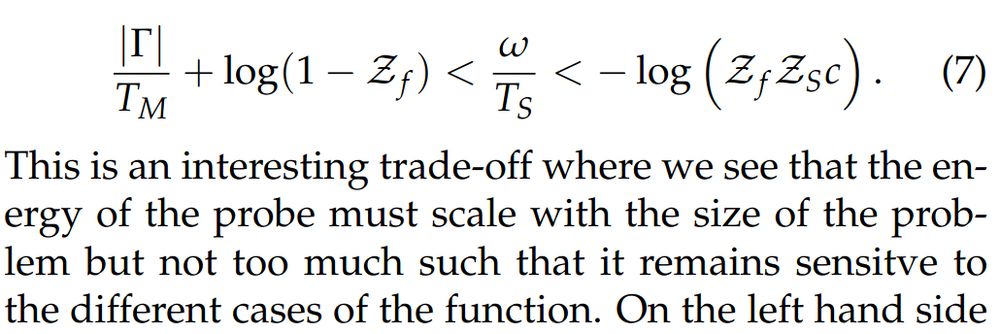

May 23, 2025 at 6:29 AM
(5/7) Fascinatingly, the probe temperature and energy must scale with the size of the problem to be sensitive to it - but not too much! Or it'll become insensitive to the difference between the different scenarios.
This is my favorite insight, giving a notion of thermo cost for a query.
This is my favorite insight, giving a notion of thermo cost for a query.
(4/7) The temperature of the probe after query is now sensitive to the property of the function! We examine this for the Deutsch-Josza problem where the oracle uses an exponential no. of thermal qubits for encoding and the Bernstein-Vazirani problem where they can get away with a linear number.
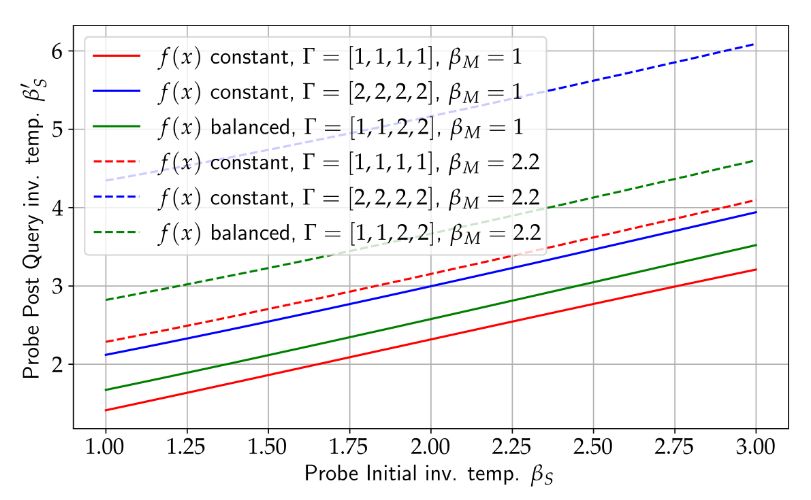
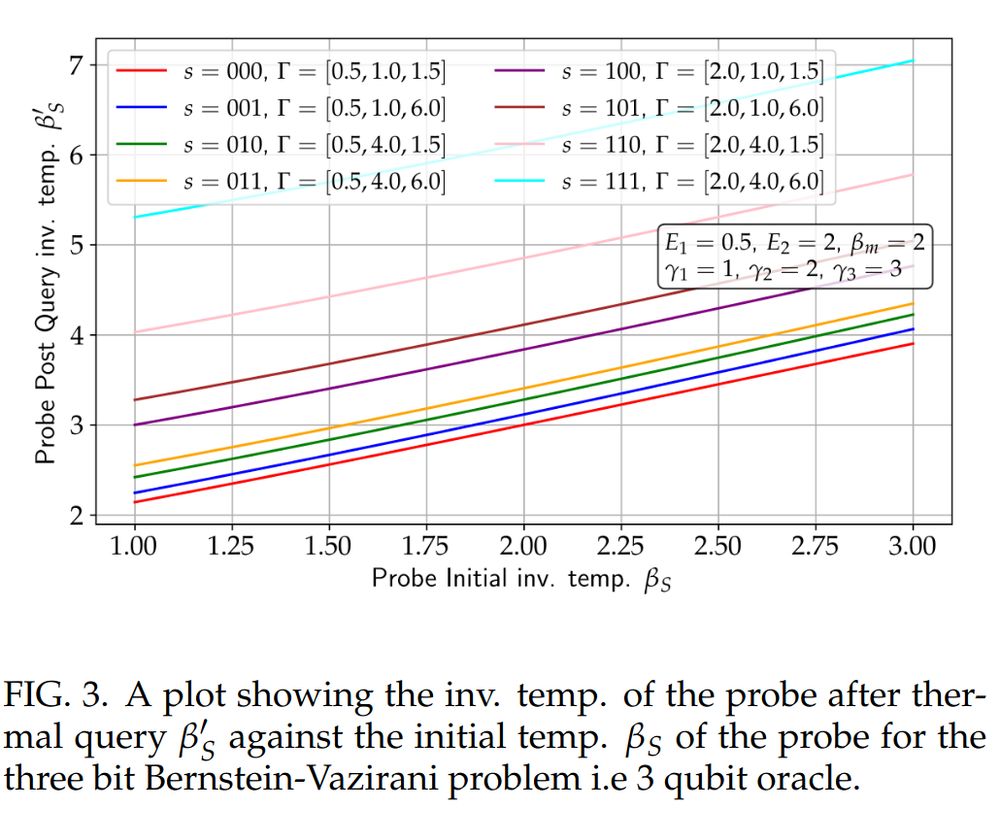
May 23, 2025 at 6:29 AM
(4/7) The temperature of the probe after query is now sensitive to the property of the function! We examine this for the Deutsch-Josza problem where the oracle uses an exponential no. of thermal qubits for encoding and the Bernstein-Vazirani problem where they can get away with a linear number.
(3/7) Here we exchange the de-excited probe + all excited machine state with its opposite - excited probe + no excitations in machine.
Because of the oracle's encoding, the all excited state contains information about the sum of the function's output!
Because of the oracle's encoding, the all excited state contains information about the sum of the function's output!

May 23, 2025 at 6:29 AM
(3/7) Here we exchange the de-excited probe + all excited machine state with its opposite - excited probe + no excitations in machine.
Because of the oracle's encoding, the all excited state contains information about the sum of the function's output!
Because of the oracle's encoding, the all excited state contains information about the sum of the function's output!

